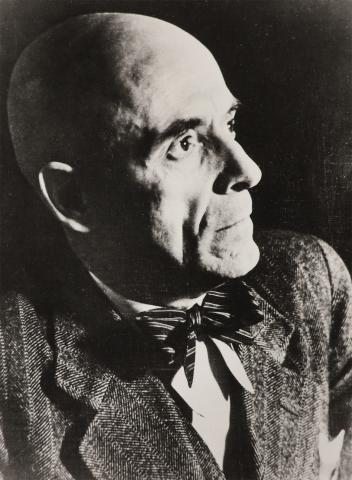After attending the k. k. Staatsobergymnasium in Klagenfurt, Bruno Grimschitz studied art history from 1910 at the University of Vienna under Max Dvořák and completed his studies at the Institut für Österreichische Geschichtsforschung (Institute of Austrian Historical Research). He had German nationalist sympathies and in 1912 joined the Akademische Landsmannschaft Kärnten in Vienna and was an officer on the Italian and Russian fronts in the First World War. In 1918 he was awarded a doctorate with a thesis on the artistic development of Johann Lucas von Hildebrandt. The following year he started his career as a research assistant at the Österreichische Galerie in Vienna, being promoted in 1928 to second-class curator and six years later to first-class curator. From 1932 he lectured in modern art history and museology at the Technical University in Vienna. In 1937 the University of Vienna authorized him to teach art history and made him an extraordinary professor in 1941.
After the annexation of Austria to the National Socialist German Reich in March 1938, Franz Martin Haberditzl, director of the Österreichische Galerie was removed from office by the Ministry of Internal and Cultural Affairs and replaced by his long-standing deputy Grimschitz. On 6 April 1938 Grimschitz submitted an application to become provisional director of the museum, which was approved on an interim basis by the Ministry in a decree of 24 May 1938. On 20 August 1938 he was appointed provisional director and on 28 December 1939 permanent director of the museum. Grimschitz, NSDAP party member since May 1938, established himself during the Nazi era as a multiple functionary and advanced to become one of the most influential personalities in the art and culture scene in the Ostmark. Apart from his undisputed expertise, the Gaupersonalamt (personnel office of the Reichsgau Vienna) emphasized his political reliability and nationalist sympathies during the period of illegality. He worked from 1929 as an expert in recent painting in the art department of the Dorotheum in Vienna and from 1938 as an assessor in the newly established Vermögensverkehrsstelle (Property Transaction Office). On 22 August 1941 the Reichskammer der bildenden Künste (Reich Chamber of Fine Arts) appointed him as an expert in the evaluation of Jewish-owned art for their culture purchasing department. He had no scruples about using the knowledge he acquired in this capacity, for example in the case of Valerie Honig. He evaluated her collection in 1938 at 49,000 Reichsmarks and, having informed the Institut für Denkmalpflege (Institute for Monument Conservation) of her deportation in 1942, asked about the whereabouts of her artworks with a view to possible acquisition. Alongside his directorship of the Österreichische Galerie, in January 1940 he became provisional director of the Picture Gallery in the Kunsthistorisches Museum until Gert Adriani took over in 1941. In October of that year he was entrusted with the directorship of the new Prinz Eugene Museum to be housed in Prince Eugene's former winter place in Himmelpfortgasse, Vienna. His German nationalist preference for rural, vital and powerful painting was in contrast to the "decadent urban view of art" of the likes of Gustav Klimt. This attitude did not prevent him from organizing a comprehensive Klimt retrospective by order of Reichsstatthalter Baldur von Schirach in the Wiener Secession in 1943. In that year, Josef Dobrowsky's contemporary portrait of Grimschitz was not admitted to the Künstlerhaus exhibition Viennese Portraits from Art and Science Circles 1900–1943, as it contained "elements of degenerate art". On 1 June 1944 the Salzburg Gauleiter Gustav Adolf Scheel entrusted him with heading the Zweckverband "Salzburger Museum", in which he cooperated closely with Friedrich Welz, art dealer and Aryanizer of Galerie Würthle in Vienna.
In an article in the daily newspaper Neues Österreich on 4 May 1945, Grimschitz pointed to his "acquisitions extensively running counter to National Socialist guidelines" during the war, including purchases of pictures by artists such as Lovis Corinth, Oskar Kokoschka and Egon Schiele. In a decree of 6 October 1945, however, the Staatsamt für Volksaufklärung, Unterricht und Erziehung und für Kultusangelegenheiten (State Office for Popular Enlightenment, Schools, Education and Cultural Affairs) nevertheless removed him from his function as director of the Österreichische Galerie on account of his former NSDAP membership and retired him permanently on 31 October 1947 as a "lesser offender". In 1956 he was reinstated at the University of Vienna as a lecturer in art history, a position he held until 1963. Twenty-six of the artworks acquired under Grimschitz's direction were reported by the interim head of the Österreichische Galerie Fritz Novotny under the Vermögensentziehungs-Anmeldungsverordnung (Regulation on the Notification of Seized Property), which entered into force on 17 September 1946, as Aryanized assets. In the post-war period the museum restituted twelve objects to their former owners or legal successors, including ten of the works declared to have been expropriated, among others, from the collections of Victor Ephrussi and Alma Mahler-Werfel.

